Physics Lab Reform Fosters Independent, Creative Thinking, Builds Student Skills
“Cause that’s a really big part of this independent, creative thinking, is to have the freedom to choose and to have the trust from your instructors that you are the expert.” – Katie Ansell
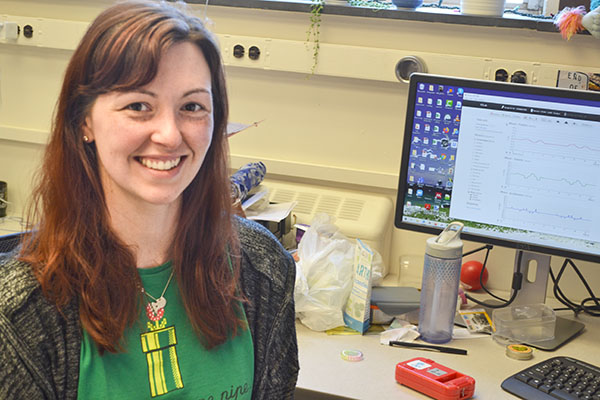
On the computer monitor behind her, Katie Ansell shows some of the data she collected using her iOLab.
April 8, 2020
In fall 2020, the Physics Department is going to finish rolling out reformed course laboratories that they’ve been developing over the last several years. But it won’t be business as usual. For instance, instead of having the 2500 or so students follow verbatim a long set of very detailed instructions, the idea is that the labs would foster independent, creative thinking, giving students the freedom to explore—and possibly even fail—just like real scientists. Another goal is that the labs will help students develop two kinds of necessary skills: expertise in doing procedures plus “invisible” or involuntary skills—expertise to do something without even thinking about it, including some life-long skills. And contrary to the instructor-student hierarchy traditionally understood in years past, it’s not the instructor who will be the expert, but the students will be the acknowledged experts of the work they’ll be doing.
According to Katie Ansell of the Physics Education Research group, developing this new lab design has been quite a process. “So the first time, it was a whole big thing because we didn’t know how to do it, right, and it was such a new way of thinking to us. In retrospect, it’s like, ‘Oh my gosh, why is it so hard to think a different way?’”
Regarding this different way of thinking, Physics Professor Mats Selen, long dedicated to innovative physics education pedagogy, says, “What you have to understand is traditionally the way that people always do labs in big institutions, or even small institutions...it's the way that we used to do them.”
How labs have traditionally been done, what Selen terms “the gold standard of labs for the whole Western hemisphere…forever,” is this:“Students were given every single instruction: ‘Click this; click this; do this; do this. Your data should look like this!’Basically the lab manual did all the thinking for them,” admits Ansell.
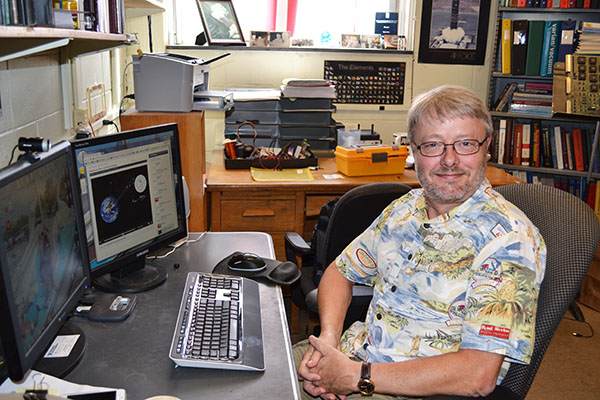
Mats Selen in his office in Loomis Lab.
How effective was the traditional way? “We've known for years that the students really didn't think that the labs were very useful,” Selen explains. Plus, research had shown that “What we were hoping the labs were doing, which was helping students really understand the concepts of the course, wasn't working.” So Selen believes that gave them license to try some new things in labs.
Enter Eugenia Etkina, a Rutgers professor who had developed the Investigative Science Learning Environment physics class format. In 2014, Selen saw Eugenia give a talk about her philosophy of teaching physics and labs, which focuses on students learning science in a way that reflects the scientific process. She thinks the way students learn science should resemble the way it’s practiced. “You see something and you say, ‘Oh, I want to learn more,’ and ‘Oh, I think I understand what’s going on here,’" Ansell explains. "So you make an observation, then you form some ideas that could explain it. Then you test those ideas. Right? And then, once you’ve tested and eliminated as many ideas as you can, you’re left with things that you can use until further testing shows that maybe you need to reject your idea and come up with something new.”
“That kind of changed my view of everything that we were doing,” Selen admits, claiming their exposure to Etkina’s teaching philosophy got them “on the right track.”
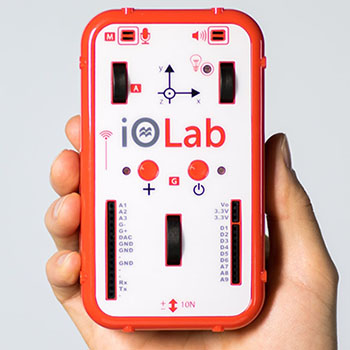
An iOLab (Image courtesy of Youtube.)
Ansell says the iOLab could also improve accessibility to students who lack access to lab equipment,“a piece of multipurpose lab equipment that you could get into high schools,” she explains, giving students whose schools lack equipment the ability to do labs,“because to buy all the different [tools] to do the same kind of stuff would cost a lot more than to have one simple device.”
The idea was also to foster informal learning. “Because the device is flexible, because you can take it anywhere,” she reports, the goal was to change more formal physics labs by tapping into “informal, creative things that we at least assume that our students are doing anyway in their daily lives: you have a problem, you figure out a clever solution to it, and you feel really good about yourself. But also it’s fun.”
Ansell claims both she and Selen are more on the experimental side of physics. “That’s something we both really identify with—that there is this sort of tinkering and curiosity like, ‘I just want to know, and this is interesting.’ The two saw the iOLab as an opportunity to move out of the classroom.
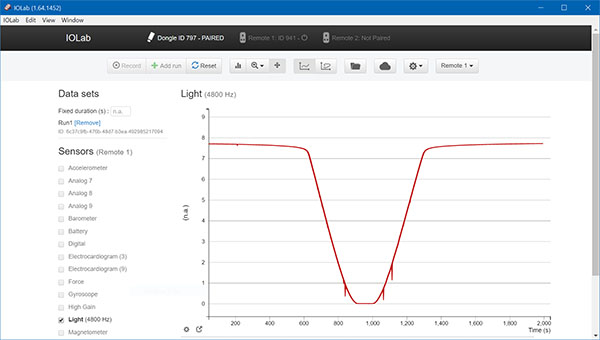
Ansell's iOLab 2017 Eclipse Readings. (Image courtesy of Katie Ansell.)
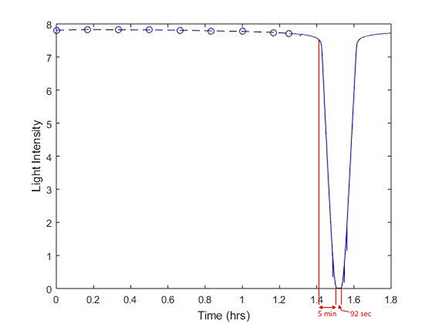
Ansell's Annotated Graph of the Eclipse's Light Intensity. (Image courtesy of Katie Ansell.)
Ansell shares an out-of-the-classroom instance where she personally found the iOLab to be quite helpful: the solar eclipse of 2018. She had gone down to Carbondale with friends and took her iOLab with her. “I set it up with the light sensor because, being the nerd that I am, I was like, ‘I can take data; I want to look at this.’ And I had so much fun and…it was really easy to do.” She adds that with a tool like iOLab, students, “can just decide, ‘I want to measure. I want to see what this looks like!’”
Here’s a brief timeline of Physics’ lab reform efforts. Selen first started playing around with the iOLab in his lab sections back in 2011–2012 using 25 or so prototypes. Then, in fall 2015, he and Ansell began more systematic implementation targeting Physics 211, a calculus-based physics mechanics course for engineering/physics majors. Their first effort involved only a portion of the students—one lab section. “We never did it in a full class,” Ansell admits. “We were like, ‘We need to figure out how to do this before we ask a thousand students to do it.’” Plus, they only did three class meetings of one section, saying, “We want to make sure this won’t be a train wreck!” In spring 2016, they implemented reform for the whole semester in three Physics 211 lab sections (about 100 students) out of a total of 39 sections. Next, the two decided that to figure out how to scale up to a thousand students, they first needed to figure out how to scale up a smaller class of around 300. So they shifted reform efforts to Physics 101, an algebra-based course, in Spring 2017. In spring 2020, prior to the big fall rollout, reforms in the various introductory Physics courses impacted around 1600 students.
Ansell shares some pitfalls and challenges they encountered on their road to reform. Their first attempts with the lab curriculum involved having students do activities at home following online instructions. “But we’d told them how to do them with a lot of instructions, and that didn’t work.”
She also says she and Selen first focused on teaching physics concepts through activities. “But when you want to teach physics concepts with activities, you really rely on students being able to get the result we thought they were going to get. And they weren’t.”
For some reason, students were getting different results, possibly due to careless mistakes, not understanding the system, or because the materials they had at home were different. However, that got Selen and Ansell really thinking about their goals for their physics labs. They started asking themselves, “How do we set students up to succeed instead of giving them opportunities to fail?” Based on their epiphany, they revamped their goal from teaching physics concepts to having students do things that were more creative and flexible: “Like all the things that are fun and exciting about doing science,” says Ansell.
Contributing to their paradigm shift was Eugenia Etkina (see above), who encouraged them to trust their students more. “The thing that we learned was that if you give a lot of instructions, especially at home when social support isn’t there, that it doesn’t work. But if you create spaces for students to succeed, then they will, and you can ask students to try things…So we really changed our philosophy with using the iOLab at home,” Ansell explains. Now, all course components, from lectures to discussion sections to labs are interwoven so that students generate their own physics knowledge. Ansell explains:
“What we really wanted was for students to make choices for themselves and to start getting comfortable making choices for themselves. Cause that’s a really big part of this independent, creative thinking, is to have the freedom to choose and to have the trust from your instructors that you are the expert. That it’s not that your instructor is the expert, but that the students are actually the experts of the work that they’re doing.”
How might that play out in a lab? One activity might ask students to measure something. However, they'd have to decide for themselves how to take the measurements, what parts of the data to look at, and how many trials to do. Ansell says "how to interpret their data", was a really big area, because most freshmen’s lab experience had been: “You’re going to tell me what to do, and I’m going to get the right answer that agrees with the physics equations that I’ve learned.”
However, in addition to fostering independent, creative thinking, another important emphasis of the reform efforts involved fostering student development of skills. According to Ansell, when scientists do something a lot, they become experts, developing two kinds of skills. “One is procedural skills,” she states. “So you get really good at doing procedures over and over." The reformers learned this lesson the hard way. While working with the three sections in spring 2016, though they'd planned the curriculum pretty far ahead, they ended up having to develop content on the fly because students were having trouble with different subtasks—something the curriculum developers hadn’t anticipated. “You discover, ‘Oh, they’re not getting this, and then, they’re not getting this,’” Ansell recalls.
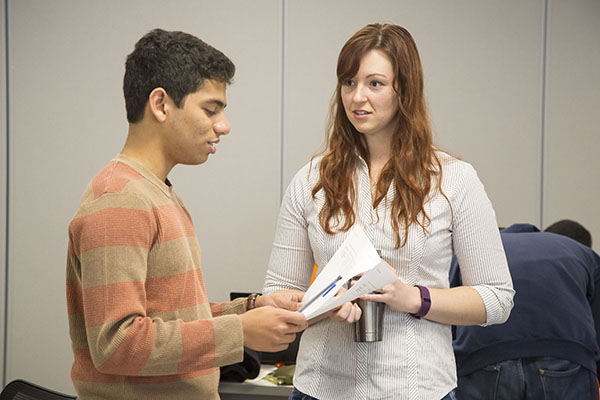
Katie Ansell helps a Physics 211 student resolve an issue he's having with the lab instructions. (Image courtesy of Brian Stauffer.)
Another expertise is related to what one does"without thinking about it...sort of invisible skills.” She compares these to riding a bike. “You’re not thinking about riding your bike, right? You don’t think, ‘Oh, I have to do this to turn!’ You just turn right. And if you spend enough time doing physics experiments, then you also do the same thing. You tell yourself, ‘Oh, I don’t have to think about how to do this. I just do it!’”
Here’s an example: one challenging subtask taking time and energy away from doing the experiment was picking the part in the graph to be considered. Once instructors discovered this, they immediately designed a pre-lab focused on interpreting graphs.
Selen adds that students are also learning skills “useful outside of physics: critical-thinking skills, and design skills, and communication skills, and things like that; so it's useful not just for being able to do physics problems, but it's more of a general thing that you can use in your whole life.”
Regarding setting students up to succeed, Ansell says it’s important that “The prompts for the classroom are more meaningful in the sense that we don’t ask students to discover something they already know, because that only sets them up to fail. Right?” For instance, should they ask students to measure the value of the acceleration due to gravity, a number, she says, “Either you get it, and you’re good,” but, “If they can’t get it, all they learn is that they’re bad at doing physics experiments, and we don’t want them to learn that, right? Instead, prompts for the classroom address meaningful tasks—things for which, to some degree, the answer depends on the way students set up their experiments.
But if there is no "right answer," how are students graded? “By showing evidence that they followed a careful scientific process,” she explains. “Getting a certain answer is never part of the grading. But part of the grading is that they make a conclusion that is supported by evidence from their experiment, which is really uncomfortable for students at the beginning.”

Katie Ansell and Mats Selen (center, standing) work with a student using an iOLab in a Physics 211 lab session (Image courtesy of Brian Stauffer.)
Regarding incorporating iOLab into one's labs, Selen likens the whole process to "catching the iOLab disease." "So the first step is you go, 'Oh, that's cool. This thing costs a lot less than this expensive equipment I have. So let's see what experiments I'm doing now I can do with this instead.'" Phase two of the disease is you go, "'Well, okay, I see I can't do this experiment because there's friction in the wheel (on the iOLab) and it doesn't roll forever without stopping.' But then you go, 'But I could use that actually to my advantage because in the real world, things have a little friction when they roll. So I can have the students measure this, and that's kind of a bit more close to reality than the sort of ideal experiments that they tried to do before.'" "Phase three is: 'So what other experiments can I do that I didn't do before?''" Finally, phase four is: "'Oh, this is better than what I was doing before.' But the first step is always thinking, 'Okay, how can I do what I was doing before?' This is normal human behavior."
What’s the next step for Physics in terms of lab reform? Ansell believes things are going so well that before long, the department will want to add Physics 213 and 214, two half-semester courses addressing thermodynamics and quantum mechanics, which are part of its calculus-based sequence. They’re not part of the current project, but Ansell predicts: “But I think sort of a next step, the department is kind of saying, ‘Hey, so when are you going to do these too?’ Which really feels really good to me.”
Not only did Ansell help to create and implement this new way of teaching labs, but she assessed its effectiveness as well. In fact, she recently defended her dissertation and was awarded a PhD in Physics for her research assessing of the Physics Lab Reform’s effectiveness. She found it quite rewarding to defend her work: “So I get to tell this story about this thing that I cared about a lot, and then it worked, and I’m going to show you that it worked.”
One finding was: “Students from the new lab format were a lot more mindful about the choices that they were making for their experiment design, in terms of ‘How will this help us get a better result?’ compared to their peers, who just did things and just reacted to things instead of preparing.”
Regarding how beneficial reforms have been for students, Ansell shares, “I’m just so happy that we’re giving students agency. Students are getting the room to be smart because they are, they are so smart, and then we’re giving them the room to do it, and they feel good when they get to do it.”
Regarding how Selen hopes their reforms impact students, he envisions it being long-term. "My dream is that 10 years after they leave university, that they can think like a scientist...You want to give them a skill that stays with them for their career and for their lives." He's hopeful that they will know enough about experiments that when they see a news story that quotes numbers from some poll or some scientific results that they know enough to either say, 'Oh, that looks like a pretty solid result' or 'those conclusions do not seem consistent with the data they are showing.'"
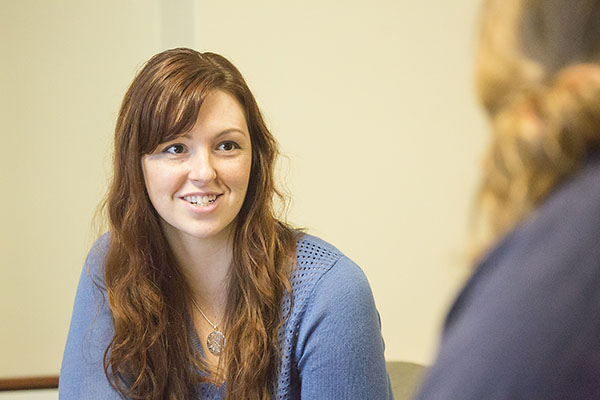
Katie Ansell interacts with one of the Physics 211 students during their first pilot course. (Image courtesy of Brian Stauffer.)
In terms of how rewarding the two have found the project, Ansell admits: “I’m really proud of what we’ve built,” adding:
“So at this point, I feel just so happy because something that started out as a project that was going to have an impact, but we weren’t sure what was gonna happen out of it, developed into something that we can see—everyone can see without even needing the measurements. It’s really clear to everyone that this is something good.”
She believes the department also recognizes the benefits of the reforms, and that’s why they want it in all the intro classes, not just the four they originally planned to do.
“Because it’s so good,” she acknowledges. “And the TAs said they can see it; the instructors can see it; the students can see it. And personally, it’s really nice to step back and be like, ‘I made this.’”
Regarding the many reform efforts Selen has helped Physics implement over the years, including the iClicker, SmartPhysics, the iOLab, and now lab reform, Selen credits his colleagues, his department, and his love for tinkering. In addition to acknowledging Katie Ansell for her work on lab reform, he credits Gary Gladding and Tim Stelzer for their many contributions. Calling Stelzer "the big picture guy," he adds, "He has this amazing skill to see what's needed." Stelzer would realize,"'Oh, Selen, he likes to tinker," then say to Mats, "'Why don't you tinker with this? We need this clicker thing'" (or whatever was needed). After starting the project, Selen would realize, "''Oh, this is kind of fun,' but it never would have happened if it wasn't for Tim."
He also thanks Physics and Grainger College of Engineering. "The fact that our department and our college has been supportive through all this has been huge. Right? We're changing the way that we do these labs, and we have data to show it's better. But they've been very supportive through my entire career here, just doing screwball things. And it's very nice to be in a place where your department and your college has your back.
But much of these reforms wouldn't have come about if it weren't for Selen's penchant for tinkering. "Honestly, the reason that I started to play with this, just because it was fun. I like to build things and tinker. And so for me, just as a tinkerer, that's really how this got started. I mean, that's the story of my life, right?"
How likely is it that Physics' lab reforms might catch on at other schools? Selen admits: "Other places are definitely ahead of us when it comes to using IOLab for online instruction, for example, but I think its fair to say that we are ahead of the curve when it comes to using IOLab to develop critical thinking in face-to-face labs. I would guess that once other universities see what is being done at the University of Illinois and they see that we aren't damaging our students, and, in fact, the students like it better and they seem to have useful skills when they finish, then I think this approach will spread."
Story and photographs by Elizabeth Innes, Communications Specialist, I-STEM Education Initiative.
More: Faculty Feature, Physics, Undergraduate Education Reform, 2020
For more on the Physics Education, see the I-STEM articles:
- 2020: Spencer Hulsey, the Face of the Physics Van: Passionate About Physics—and Outreach
- 2020: Physics Van Uses Exciting Demos to Pique Students’ Interest in Science
- 2013: Physics Van: A Whole Lot of Fun… Plus, You Get to Blow Stuff Up
- 2013: Mats Selen–Changing the Way Physics is Taught.
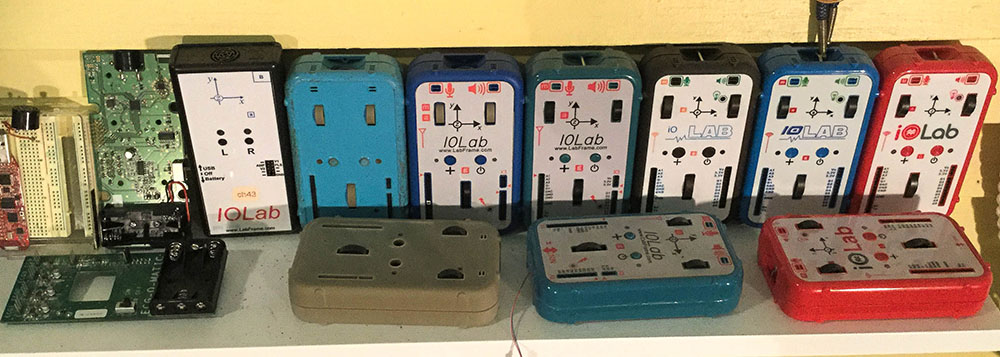
The many iOLab iterations. (Image courtesy of Mats Selen.)













.jpg)
















